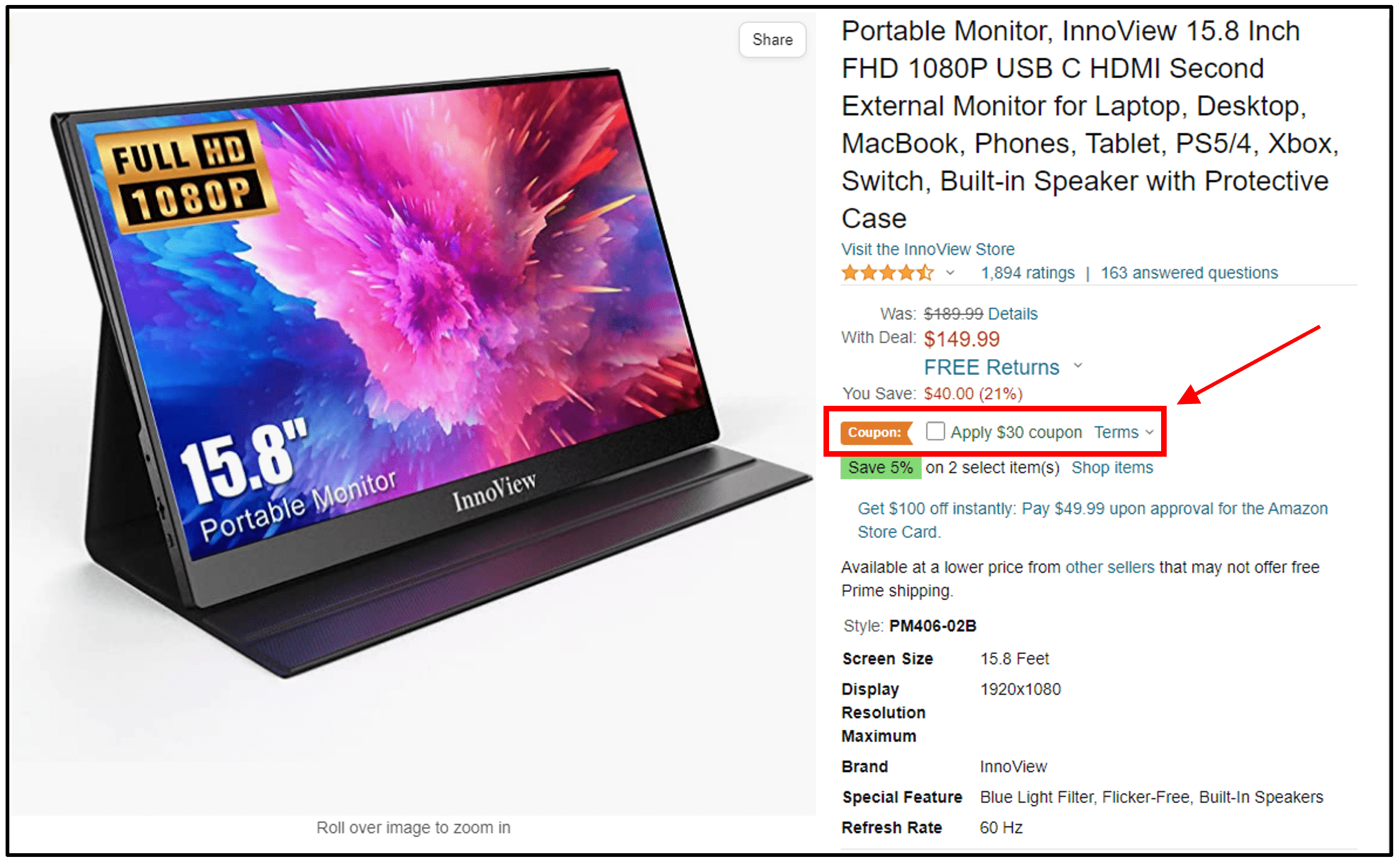
Amazon – the company that’s famous for its effortless customer experience – is curiously making it a little harder for people to buy stuff through its website. But there’s a method to their madness.
On numerous product pages, the online retailer will sometimes display a checkbox that the user has to click on in order to apply an available coupon (in the example below, an additional $30.00 off the already discounted $149.99 price).

Let’s remember, this is a retailing legend that has been relentless in removing friction from the purchase experience. This is the company that pioneered (and patented) the 1-Click Purchase Button, introduced voice-activated purchases (through Alexa), and launched a sensor-outfitted grocery store (Amazon Go) that completely eliminates the need for customers to checkout.
Why on Earth, then, would Amazon want to inject more effort into the purchase process with these coupon checkboxes? Why not just automatically include the coupon in the posted price?
The answer is that Amazon has a very nuanced understanding of all the ingredients that figure into creating an engaging customer experience.
Yes, effortless interactions do matter, and customers appreciate convenience. But that’s not the only way to a consumer’s heart. There are actually a discrete set of strategies that beloved businesses use to turn more sales prospects into customers, and more customers into lifelong fans. Making the experience “effortless” accounts for only one of them. With its curious coupon checkbox, Amazon is capitalizing on a couple others that I wrote about in my recent book:
Give the Perception of Control
It’s human nature that we are control freaks. We like to have command over what’s going on around us (or at least the perception that we’re in command). And, so, when you make a customer feel as though they are in control of an experience – that they can influence it, shape it – then they’re much more likely to feel good about the whole encounter.
The mere act of checking a box to apply a coupon provides that sense of control to the Amazon consumer, creating a more engaging purchase experience that helps turn browsers into buyers (thereby avoiding the bane of all online retailers – cart abandonment).
With the coupon checkbox, Amazon is essentially encouraging its customers to feel more invested in the purchase process by giving them greater perceived influence over it.
Stir Emotion
As famed social psychologist (and NYU professor) Jonathan Haidt once put it: “The emotional tail wags the rational dog.” Customers’ impressions of an experience will largely be influenced not by their logical evaluation of the encounter, but by its emotional resonance. Put simply – how did it make the customer feel?
When a consumer feels like they’ve scored a great deal on a product, it stirs positive emotion. And that emotion is accentuated when the consumer must invest some modicum of effort to earn the reward. (Snagging a great deal on a product feels all the more exhilarating when you had to hunt a bit for it.)
The coupon checkbox serves to amplify the positive emotion that an Amazon consumer feels when making a purchase, creating an additional behavioral nudge for them to complete the transaction – and to view their Amazon experience favorably.
* * *
Amazon (like all legends in the customer experience arena) doesn’t do anything by accident. Their customer experience is carefully and thoughtfully constructed – right down to the presence of a coupon checkbox. The fact that the checkbox exists at all is a strong indication that, in Amazon’s real-world testing, it made a substantive, positive difference in purchase behavior and consumer sentiment.
It’s also worth noting that this isn’t just a website user interface trick. The idea of balancing customer convenience with other (sometimes more powerful) experience design considerations is a strategy that successful companies like Costco, IKEA and Aldi have long embraced.
Think about it: Shopping in Costco’s cavernous warehouses (all of them devoid of any aisle signage) is hardly effortless. But Costco’s target market loves that shopping experience, in part, because it stirs positive emotion. It gives them the thrill of the hunt – snaking through the aisles, discovering great deals, and proudly accumulating their impressive (and social media shareable) “Costco haul.”
The key lesson for any business is simply this: There’s more than one way to create engaging customer experiences. The companies that do it best carefully balance numerous experience design strategies to create the desired end state. Minimizing customer effort, providing customers with a sense of control, stirring appealing emotions — these are just a few of the proven techniques that any organization can use to become a more beloved business.
The highlighted example from Amazon notwithstanding, achieving customer experience excellence is never a rote “check the box” exercise. There’s a distinct science to turning everyday customers into brand advocates, and Amazon’s simple little checkbox speaks volumes about how to do it.
[A version of this article originally appeared on Forbes.com.]
Jon Picoult is founder of Watermark Consulting, a customer experience advisory firm that helps companies impress customers and inspire employees, creating raving fans that drive business growth. Author of “FROM IMPRESSED TO OBSESSED: 12 Principles for Turning Customers and Employees into Lifelong Fans,” Picoult is an acclaimed public speaker, as well as an advisor to some of world’s foremost brands. Follow Jon on Twitter or Instagram, or subscribe to his monthly eNewsletter.